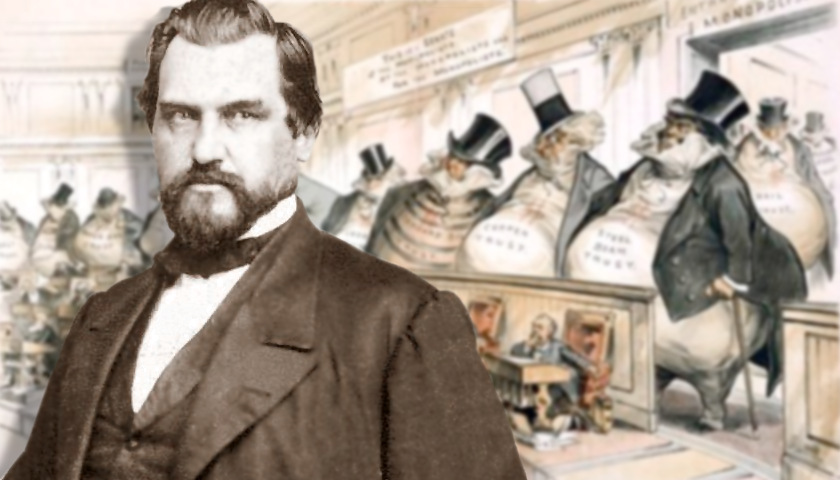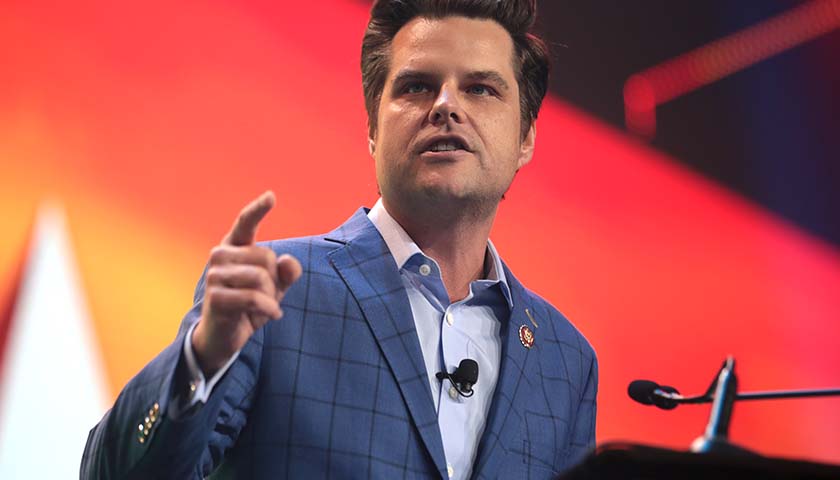by Burton Folsom
We study history to learn from it. If we can discover what worked and what didn’t work, we can use this knowledge wisely to create a better future. Studying the triumph of American industry, for example, is important because it is the story of how the United States became the world’s leading economic power. Free markets worked well; government intervention usually failed.
Capitalism Worked, but We Were Told It Didn’t
The years when this happened, from 1865 to the early 1900s, saw the U.S. encourage entrepreneurs indirectly by limiting government. Slavery was abolished and so was the income tax. Federal spending was slashed and federal budgets had surpluses almost every year in the late 1800s. In other words, the federal government created more freedom and a stable marketplace in which entrepreneurs could operate.
To some extent, during the late 1800s—a period historians call the “Gilded Age”—American politicians learned from the past. They had dabbled in federal subsidies from steamships to transcontinental railroads, and those experiments dismally failed. Politicians then turned to free markets as a better strategy for economic development. The world-dominating achievements of Cornelius Vanderbilt, James J. Hill, John D. Rockefeller, and Charles Schwab validated America’s unprecedented limited government. And when politicians sometimes veered off course later with government interventions for tariffs, high income taxes, anti-trust laws, and an effort to run a steel plant to make armor for war—the results again often hindered American economic progress. Free markets worked well; government intervention usually failed.
Why is it, then, that for so many years, most historians have been teaching the opposite lesson? They have made no distinction between political entrepreneurs, who tried to succeed through federal aid, and market entrepreneurs, who avoided subsidies and sought to create better products at lower prices. Instead, most historians have preached that many, if not all, entrepreneurs were “robber barons.” They did not enrich the U.S. with their investments; instead, they bilked the public and corrupted political and economic life in America. Therefore, government intervention in the economy was needed to save the country from these greedy businessmen.
Extreme Sympathy for the Communist Party
Though not a member of the Communist Party, Josephson co-authored an open letter of support for the Communist Party candidates for President of the United States in 1932. “We believe,” the letter said, “that the only effective way to protest against the chaos, the appalling wastefulness, and the indescribable misery inherent in the present economic system is to vote for the Communist candidates.”
Josephson traced the troubled capitalist system of the 1930s back to the entrepreneurs of the late 1800s. Thus, by explaining what he thought was the wasteful, greedy, and corrupt development of steel, oil, and other industries under capitalism, Josephson was explaining to readers why the Great Depression was occurring. “I am not a complete Marxist,” Josephson insisted, “But what I took to heart for my own project was his theory of the process of industrial concentration, in Vol. 1 of [Marx’s] Capital, which underlay my book.”
Josephson never intended to write an objective view of American economic life in the Gilded Age. He did little research and mainly used secondary sources that supported his Marxist viewpoint. As he had written in the New Republic, “Far from shunning propaganda, we must use it more nobly, more skillfully than our predecessors, and speak through it in the local language and slogans.” Thus he wrote The Robber Barons with dramatic stories, anecdotes, and innuendos that demeaned corporate America and made the case for massive government intervention.
The Lies of The Robber Barrons
When propaganda is the goal, accuracy is the victim. The Robber Barons is riddled with factual errors. On page 14 alone, Josephson makes at least a dozen errors in his account of Vanderbilt and the steamships. Here is one sentence with three errors:
At the time of the “shipping subsidy” scandals, aired in the Senate in 1858, it was seen that Vanderbilt and E. K. Collins of the Pacific Mail Steamship Line were the chief plunderers, sometimes conciliating, sometimes blackmailing each other.
First, E. K. Collins was never the head of the Pacific Mail Steamship Line; in fact, he had no connection with it at all. Second, Vanderbilt and William H. Aspinwall, the actual head of the Pacific Mail Steamship Line, were never “blackmailing each other.” Third, the Pacific Mail Steamship Line, not Vanderbilt, was the “chief plunderer.” Vanderbilt had no subsidy, and the Pacific Line did. In fact, Vanderbilt, through his low prices, exposed the federal subsidy as a scandal.
Perhaps more important than all of the errors, Josephson missed the distinction between market entrepreneurs like Vanderbilt, Hill, and Rockefeller and political entrepreneurs like Collins, Villard, and Gould. He lumped them all together. However, Josephson was honest enough to mention the achievements of some market entrepreneurs. James J. Hill, Josephson conceded, was an “able administrator,” and “far more efficient” than his subsidized competitors. Andrew Carnegie had a “well-integrated, technically superior plant”; and John D. Rockefeller was “a great innovator” with superb “marketing methods,” who displayed “unequaled efficiency and power of organization.”
Most of Josephson’s ire is directed toward political entrepreneurs. The subsidized Henry Villard of the Northern Pacific Railroad, with his “bad grades and high interest charges” show that he “apparently knew little enough about railroad-building.” The leaders of the Union Pacific and Central Pacific, Josephson notes, “carried on [their actions] with a heedless abandon . . . [which] caused a waste of between 70 and 75 percent of the expenditure as against the normal rate of construction.” But it never occurs to Josephson that the subsidies government gave these railroads created the incentives that led their owners to overpay for materials and to build in unsafe areas. He quotes “one authority” on the railroads as saying, “The Federal government seems . . . to have assumed the major portion of the risk and the Associates seem to have derived the profits”—but Josephson never pursues the implication of that passage.
Swooning for Stalin Josephson “enjoyed writing about my ‘scoundrels’,” and when The Robber Barons came out in March 1934, it became the number one bestselling book of non-fiction in the U.S. for six months. Even more amazing, the author was not in America to promote his book. He left for Russia to explore Stalin’s communist experiment. While there, Josephson was a celebrity and was taken on carefully guided tours of Russian steel mills and shoe factories. He attended official dinners and even talked with select Russian writers and artists. He was ecstatic. The Soviet Union, Josephson said, “seemed like the hope of the world—the only large nation run by men of reason.”
Josephson, under careful Russian supervision, never met any of the hundreds of thousands of Ukrainians who were starving to death at the time under Stalin’s brutal collectivization; nor did Josephson see the Soviet gulags, or prisons, where thousands of dissenters were forced into hard labor and early deaths. Josephson also never realized that the Soviet factories he saw were often directly copied from Western capitalist factories—and were funded by Stalin’s confiscatory taxation. Instead, Josephson thought he had stumbled into a workers’ paradise, the logical result of central planning and superior leaders.
“Before people pass judgment on Comrade Stalin,” Josephson wrote, “they ought to come here and see his Works, his Opus Major, in many volumes with their own eyes. It is very impressive; and few other statesmen in all history have so much to show.” In truth, Stalin had almost nothing to show. His model industries—car factories, railroads, and hydroelectric plants, for example—were borrowed or built by Americans or Europeans, often with grain confiscated from starving Soviet farmers.
The Falsehoods Became the Canon
With his best-selling book out, Josephson came back to America to glowing reviews and massive sales. For example, historian Allan Nevins called The Robber Barons a “tour de force” and the Virginia Quarterly Review proclaimed it to be “required reading.” Even more important to Josephson, his progressive vision of economic history began infiltrating the writing of high school and college texts. The term “robber barons” became the new label for America’s leading entrepreneurs of the late 1800s—and beyond. Historian Thomas Brewer, who in 1970 edited The Robber Barons: Saints or Sinners? observed that the majority of writers “still adhere to the ‘robber baron’ interpretation.” Historian David Shi agrees: “For well over a generation, The Robber Barons remained the standard work in its field.” For many textbook writers, it still is. In the main study guide for the Advanced Placement U.S. history exam for 2015, the writers say,
America [1877-1900] looked to have entered a period of prosperity with a handful of families having amassed unprecedented wealth, but the affluence of the few was built on the poverty of many.
Having condemned American entrepreneurs and promoted more government as the solution, Josephson began work on a sequel called The Politicos, which described the politics of the Gilded Age. Like his research for The Robber Barons, Josephson mainly did quick reading of those secondary sources in sympathy with his ideas. His book was hastily written and riddled with errors and distortions. In fact, Josephson confessed to Charles Beard that “in spite of all my precautions there might be a good many historical inaccuracies in my book.” Beard retorted, “All works of history are inaccurate,” and he urged Josephson to publish his book anyway, which he did.
If Josephson’s research was so sloppy, and his interpretation so biased, how did his Robber Baron view come to prevail in the writing of U.S. history? First, Josephson published his book in 1934, in the dark days of the Great Depression. Progressive historians had begun to dominate the writing of history and they were eager to blame a new generation of robber barons for the collapse of the American economy. The Robber Barons was embraced by key Marxist historians, who influenced much of the historical profession after World War II.
In doing so, these historians overlooked the ruinous government interventions under Presidents Hoover and Roosevelt that helped spark the Great Depression and cause it to persist. Those harmful federal policies include the Federal Reserve’s untimely raising of interest rates, making it harder to borrow money; President Hoover’s blundering Farm Board; his signing of the Smoot-Hawley Tariff, the highest in U.S. history; and his disastrous Reconstruction Finance Corporation, which dispensed massive corporate bailouts to political entrepreneurs. Finally, Hoover muzzled investment by repealing the Mellon tax cuts and promoting a huge tax hike. These various interventions stifled market entrepreneurs and emboldened political entrepreneurs. But historians have neglected that part of the story.
A second reason for Josephson’s triumph is that The Robber Barons was embraced by key Marxist historians, who influenced much of the historical profession after World War II. Richard Hofstadter, for example, was a long-time professor at Columbia University. He twice won the Pulitzer Prize, he wrote best-selling history books, and he helped train a generation of prominent historians. Yet Hofstadter had joined the Young Communist League in college and later joined the Communist Party. “My fundamental reason for joining [the Communist Party],” Hofstadter said, “is that I don’t like capitalism and want to get rid of it.” Although Hofstadter soon quit the Communist Party, he maintained his hostility to capitalism and expressed it in Social Darwinism in American Thought, in The Age of Reform, and in a popular co-authored textbook, The United States: The History of a Republic.
– – –
Burton Folsom is a contributor to IntellectualTakeout.org.




